Edit: I apologize everybody. I used the term "jagged array" when I actually meant to say "multi-dimensional array" (as can be seen in my example below). I apologize for using the incorrect name. I actually found jagged arrays to be faster than multi-dimensional ones! I have added my measurements for jagged arrays.
I was trying to use a jagged multi-dimensional array today, when I noticed that it's performance is not as I would have expected. Using a single-dimensional array and manually calculating indices was much faster (almost two times) than using a 2D array. I wrote a test using 1024*1024 arrays (initialized to random values), for 1000 iterations, and I got the following results on my machine:
sum(double[], int): 2738 ms (100%)
sum(double[,]): 5019 ms (183%)
sum(double[][]): 2540 ms ( 93%)
This is my test code:
public static double sum(double[] d, int l1) {
// assuming the array is rectangular
double sum = 0;
int l2 = d.Length / l1;
for (int i = 0; i < l1; ++i)
for (int j = 0; j < l2; ++j)
sum += d[i * l2 + j];
return sum;
}
public static double sum(double[,] d) {
double sum = 0;
int l1 = d.GetLength(0);
int l2 = d.GetLength(1);
for (int i = 0; i < l1; ++i)
for (int j = 0; j < l2; ++j)
sum += d[i, j];
return sum;
}
public static double sum(double[][] d) {
double sum = 0;
for (int i = 0; i < d.Length; ++i)
for (int j = 0; j < d[i].Length; ++j)
sum += d[i][j];
return sum;
}
public static void Main() {
Random random = new Random();
const int l1 = 1024, l2 = 1024;
double[ ] d1 = new double[l1 * l2];
double[,] d2 = new double[l1 , l2];
double[][] d3 = new double[l1][];
for (int i = 0; i < l1; ++i) {
d3[i] = new double[l2];
for (int j = 0; j < l2; ++j)
d3[i][j] = d2[i, j] = d1[i * l2 + j] = random.NextDouble();
}
//
const int iterations = 1000;
TestTime(sum, d1, l1, iterations);
TestTime(sum, d2, iterations);
TestTime(sum, d3, iterations);
}
Further investigation showed that the IL for the second method is 23% larger than that of the first method. (Code size 68 vs 52.) This is mostly due to calls to System.Array::GetLength(int). The compiler also emits calls to Array::Get for the jagged multi-dimensional array, whereas it simply calls ldelem for the simple array.
So I am wondering, why is access through multi-dimensional arrays slower than normal arrays? I would have assumed the compiler (or JIT) would do something similar to what I did in my first method, but this was not actually the case.
Could you plese help me understand why this is happening the way it is?
Update: Following Henk Holterman's suggestion, here is the implementation of TestTime:
public static void TestTime<T, TR>(Func<T, TR> action, T obj,
int iterations)
{
Stopwatch stopwatch = Stopwatch.StartNew();
for (int i = 0; i < iterations; ++i)
action(obj);
Console.WriteLine(action.Method.Name + " took " + stopwatch.Elapsed);
}
public static void TestTime<T1, T2, TR>(Func<T1, T2, TR> action, T1 obj1,
T2 obj2, int iterations)
{
Stopwatch stopwatch = Stopwatch.StartNew();
for (int i = 0; i < iterations; ++i)
action(obj1, obj2);
Console.WriteLine(action.Method.Name + " took " + stopwatch.Elapsed);
}
